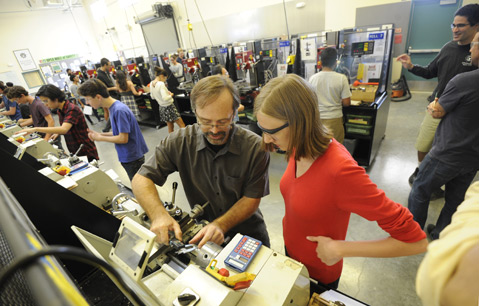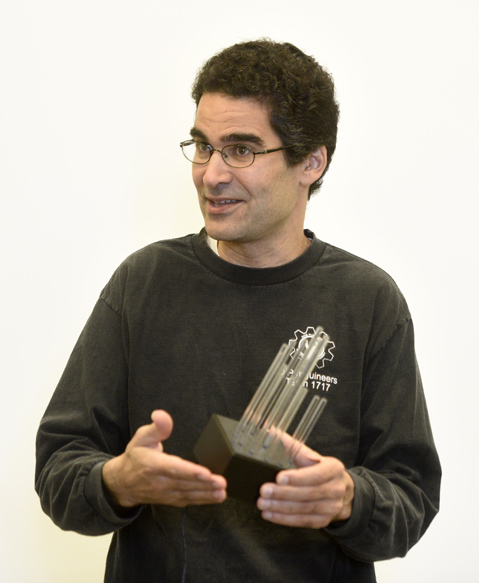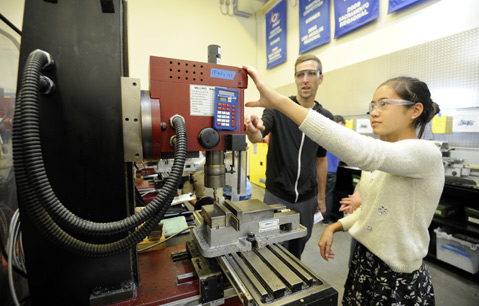Engineers of Alliance
Dos Pueblos Forges Innovative Partnerships with Adams and Crane

During the past 13 years, students of Dos Pueblos High School’s innovative Engineering Academy have advanced its reputation nationwide with award-winning projects built by teen brains buzzing with physics, mechanics, computer-aided design, and art. But to the program’s founder and director, UCSB-trained physicist Amir Abo-Shaeer, it wasn’t making the local impact he had imagined.
“People are flying in from across the county to see what we do,” he said, “but much of our own [school] district didn’t even know what was going on.” That’s now changing, due in part to cutting-edge partnerships the Dos Pueblos Engineering Academy (DPEA) has forged with two South Coast schools, one within its own Santa Barbara Unified School District, and the other a private K-8 in Montecito.

In the public realm, Adams Elementary School 5th-grade teacher Sean Federbusch — who spent a decade in the tech world before switching over to teaching five years ago — is spending the 2015-16 school year on a sabbatical of sorts, working full-time at DPEA to absorb its philosophy and techniques so he can bring them back to the Adams Design Center, a brand-new, 2,000-square-foot classroom funded by 2010 ballot measures Q and R.
Initially, the space was destined to become a computer lab, “but that sounded so archaic,” said Principal Amy Alzina, who, on a tip from Federbusch last year, became intrigued with Stanford University’s d.school, a multidisciplinary design program. She wanted something similar for Adams kids. It turns out, Alzina was delighted to learn, that similar cross-pollinating pedagogy had been the norm for years just up the highway at DPEA. Coincidentally, Alzina said, Abo-Shaeer was looking to expand DPEA’s program into primary grades. With a blessing from Santa Barbara Unified’s superintendent and board of directors, the partnership was born. Next fall, all of Adams’ students, K-6, will study Federbusch’s now-evolving curriculum as part of the school’s design, art, and music rotation.
“The idea is that if this works at Adams, it’ll spread to other elementary schools in the district,” Alzina said.
In the meantime, a similar partnership is preparing two Crane Country Day School teachers — Sabina Funk, an art teacher and fabricator, and Joe Donahue, who specializes in computer science and robotics — for the private K-8’s Oak Tree Quad, a $4.5 million expansion that includes an engineering and design center. As with Federbusch’s arrangement, Funk and Donahue will simultaneously teach this year at DPEA while absorbing and reinventing its lessons for younger students back at Crane.
Before partnering with DPEA, Crane was already a few years into the development of its engineering program, “but we had some blanks that needed to be resolved,” said Head of School Joel Weiss. During a DPEA tour with a visiting educator in February, Weiss and Crane Board President Tom Kenny were impressed with the facility and its founder, Abo-Shaeer. The lightbulb went off for Weiss and Kenny — some sort of collaboration with DPEA was in order, especially after hearing that Abo-Shaeer needed more hands to help out. “It was very serendipitous,” Weiss said. “[DPEA’s] need was more high-level teachers. Our need was a degree of expertise. The best partnerships happen when both sides are invested with the other.” If construction of Oak Tree Quad stays on track, its engineering and design center — sometimes refereed to as a maker space — will be filled with students next fall.

At the same time, DPEA will be tackling the steady constant of drumming up about $680,000 each year to keep the lights on in its 18,000 square feet of workspace. The program has expanded over the years, this year maxing out at 400 students, half of whom are female. Typically, the program gets 300 applications for the 100 freshmen spots that open up each fall.
As DPEA becomes even more popular, the rally for funding is nonstop, according to DPEA Foundation boardmember Gary Simpson, whose son went through the program, graduating in 2011. “Our cost per student has gone up, but so has the richness of the educational experience,” he said. Abo-Shaeer said that DPEA kids are immersed in study that many engineering college students don’t get until their senior year. “I just saw that you could do really complicated things with kids and be successful at it,” he added.
To help keep funding apace with what’s happening in the classroom, Simpson said that the board has recently discussed bringing on an executive director, which would be the foundation’s first paid full-time position since it was established in 2007, to match a $3 million state grant from bond monies for technical facilities at public schools.
Also, Simpson added, there’s always hope that California will start spending much more per student annually than its estimated $8,300, which ranks it 46th in the nation.



